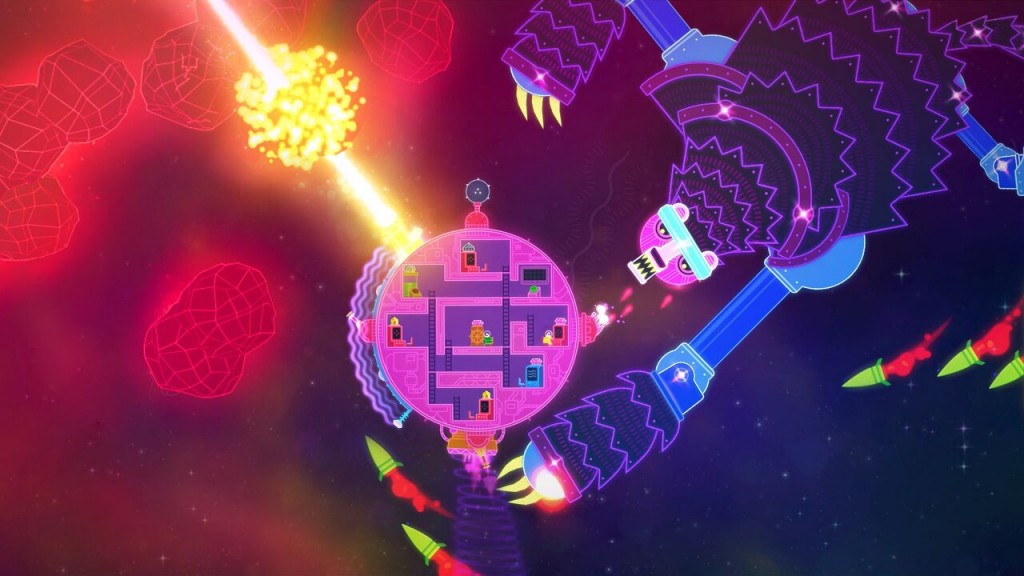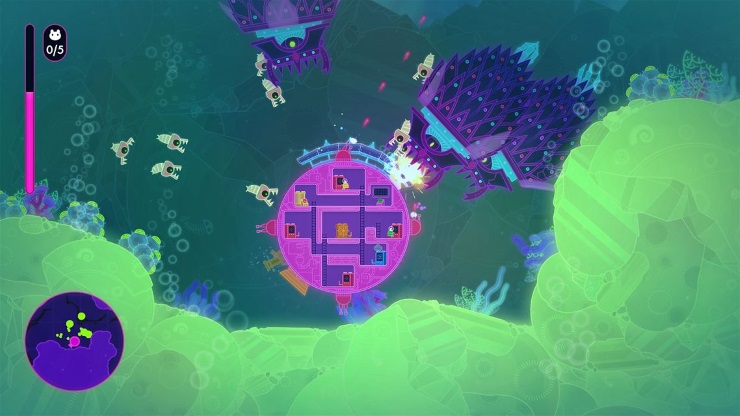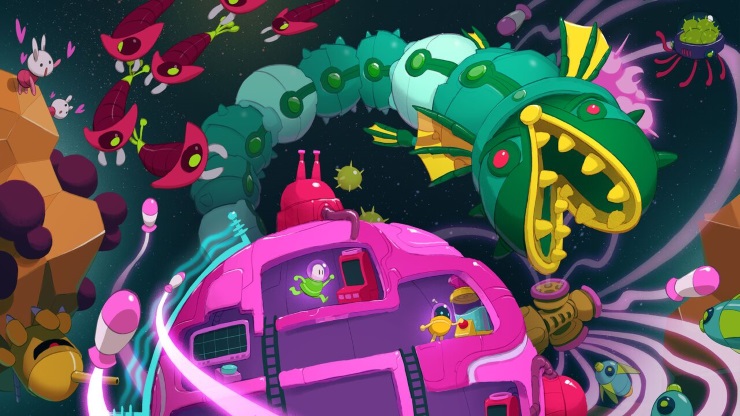September 9, 2015.
I recently got married and, as I write this, I’m only a couple of days away from jetting off on my honeymoon. When she’s not playing co-op games with me, my wife helps run an animal rescue centre, which basically means our home is a sanctuary for all sorts of cute and cuddly creatures. Now, I’ve been tasked to review a game that involves rescuing excruciatingly cute animals, while trying to operate a spacecraft with the help of another person (or AI). In a strange twist of art almost imitating life, it feels like I was destined to review Lovers In a Dangerous Spacetime. All I need is my own rocket ship, and my wife and I can do this stuff for reals. Anyone got NASA’s number?
Here’s an interesting and rather unique concept in co-operative gameplay, as you control a spacecraft yet don’t have direct control of it at all. Instead, you and a friend/AI bot have direct control over a pilot that has to operate the ship’s thrusters, shields, navigation system and weapons by walking up to a console for each function and operating it from there. This form of intergalactic plate-spinning basically means that at any one time, you can only operate two of eight consoles at one time (map, thrusters, shields, a special Yamato cannon and gun turrets at the top, bottom and both sides of your craft). It sounds complicated but, in actuality, is very easy to pick up and play – the difficulty comes from working together as a team and reacting to events.

The simple aim of this intergalactic adventure is to rescue captured animals from their space-prison cells and then leave each level through a heart-shaped wormhole (aww!), all while working as a team to overcome the many enemies and environmental barriers. Most levels are randomised, making it quite difficult to come up with a strategy until you actually start a level, especially as each of these levels are mostly covered by a “fog of war” until you explore the hidden regions. Occasionally, you’ll be given the locations of animals by opening space crates, but you’ll need to actually walk to the map console and activate it in order to see them.
You only need five animals to unlock each level’s exit, but the challenge comes in saving all ten in each level. Of course, there is a point to doing so, as rescued animals allow you to rank up and upgrade your craft or even unlock entirely new ships, with different attributes and layouts. But even the stock ship can be temporarily upgraded with various gems found in each level. These assorted shiny thingamabobs can be slotted into each console to increase their usefulness, and in time you’ll be able to add multiple gems, using similar types to multiply their power, or combine them to create entirely new effects. Your thruster can be turned into a charge beam, your turrets can become slow yet powerful lasers, and your shield can become a spiky barrier of death that protects a quarter of your ship and can actually damage enemies if contact is made.
Finding the best combinations of upgrades is certainly one of the most rewarding aspects of the game, as the player is left to their own devices to find the best combinations of gems for each scenario, and I wouldn’t say there’s an “ultimate” loadout that works best – it’s all down to personal preference and the situation at hand.

Yet, the very mechanics that make this game such a unique prospect are the same ones that can make for quite a frustrating experience. Sometimes you are simply thrown too many enemies that fire too many bullets at once, and it can be overwhelming when enemies appear from multiple sides, and you can only operate two functions at once. Does one player solely operate the shield and try to catch all the bullets, or do you both man turrets to fire hot projectile death upon all foes before they do the same to you? Sometimes it feels like there’s a modicum of luck involved as you hope that the randomly generated level you’re given doesn’t expect you to do too much at once. There are occasions where the game dissolves into an absolute bullet hell nightmare, and as your ship explodes, you’re left to ask yourself if your failure was down to the game rather than your own ability – especially during boss battles that err on the unfair at times.
But when things play out just right, there’s something immensely gratifying about genuinely playing as part of a well-oiled machine, communicating with each other and strategising each player’s role. As a couch co op game, it’s refreshing, and as the title suggests, it’s a great couples game as my wife and I had an absolute blast with it.

It’s also one of those games that has the type of presentation that makes you smile. The neon bubblegum visuals stand out, although admittedly we did have problems making out the tiny pilots, even on our 32” television screen. There’s charm in the brief glimpses of cute rabbits, frogs and all the other creatures you rescue, and hearing their off-screen pleas for help during gameplay is incredibly cute. It’s far from serious, incredibly sickly-sweet, but no less enjoyable for it.
It’s certainly a game designed to be played with another human being, as while playing single-player with an AI bot sort of works, this game is made all the better for having someone there you can communicate with. It’s the sort of game that at its best can bring people together, or when things go wrong, drive people to disagreements. It’s probably not the best game for the easily frustrated, but it’s a rare example of successful couch co op in a world of online gaming.
Great co-op.
Incredibly cute.
Wonderful mechanics.
Can be frustratingly difficult.
Not as fun in single player.
Lots to deal with.
A wonderful little sci-fi romp that may frustrate at times, but offers a great opportunity for some increasingly rare couch co-op.



